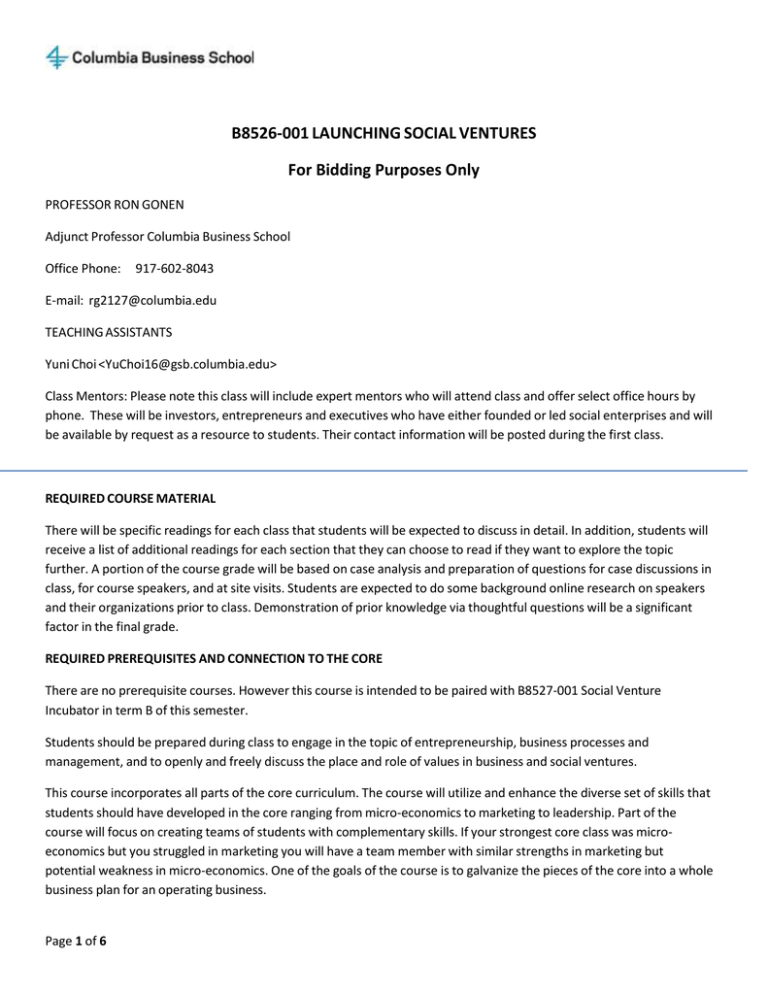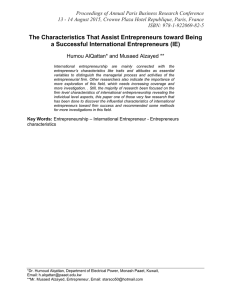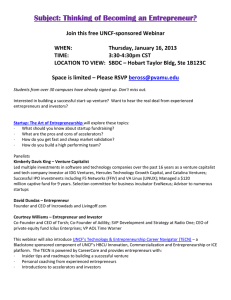B8526‐001 LAUNCHING SOCIAL VENTURES For Bidding Purposes Only
advertisement

B8526‐001 LAUNCHING SOCIAL VENTURES For Bidding Purposes Only PROFESSOR RON GONEN Adjunct Professor Columbia Business School Office Phone: 917‐602‐8043 E‐mail: rg2127@columbia.edu TEACHING ASSISTANTS Yuni Choi <YuChoi16@gsb.columbia.edu> Class Mentors: Please note this class will include expert mentors who will attend class and offer select office hours by phone. These will be investors, entrepreneurs and executives who have either founded or led social enterprises and will be available by request as a resource to students. Their contact information will be posted during the first class. REQUIRED COURSE MATERIAL There will be specific readings for each class that students will be expected to discuss in detail. In addition, students will receive a list of additional readings for each section that they can choose to read if they want to explore the topic further. A portion of the course grade will be based on case analysis and preparation of questions for case discussions in class, for course speakers, and at site visits. Students are expected to do some background online research on speakers and their organizations prior to class. Demonstration of prior knowledge via thoughtful questions will be a significant factor in the final grade. REQUIRED PREREQUISITES AND CONNECTION TO THE CORE There are no prerequisite courses. However this course is intended to be paired with B8527‐001 Social Venture Incubator in term B of this semester. Students should be prepared during class to engage in the topic of entrepreneurship, business processes and management, and to openly and freely discuss the place and role of values in business and social ventures. This course incorporates all parts of the core curriculum. The course will utilize and enhance the diverse set of skills that students should have developed in the core ranging from micro‐economics to marketing to leadership. Part of the course will focus on creating teams of students with complementary skills. If your strongest core class was micro‐ economics but you struggled in marketing you will have a team member with similar strengths in marketing but potential weakness in micro‐economics. One of the goals of the course is to galvanize the pieces of the core into a whole business plan for an operating business. Page 1 of 6 COURSE DESCRIPTION This half semester course will focus on (1) identifying opportunities to use entrepreneurship to solve social problems (2) how to develop a business plan and launch a business that has the triple bottom line: people, planet, profit at its core, and (3) how to manage a business to scale and profitability. The course will provide tools and resources for students interested in launching a business with a social mission, joining a business with a social mission, or investing in a business with a social mission. Course topics will include the development, pitch, launch, and management of a business model that solves a social or environmental problem. We will develop a road map for the launch of a social venture including a clear and effective business plan, sales methodology, fund raising plan and mission aligned Board development, mission aligned management team, and potential sale/exit of a social venture. The course will provide the tools and analysis required to: perform an in‐depth market assessment of industries and their role in society, product or service design and their lifecycle; develop a sales and marketing campaign; assess human resource requirements; build a realistic financial forecast including identifying sources of capital that are synergistic with the venture’s mission; and evaluate the potential sale of a social business while ensuring that its value system remains in place. Students interested in entrepreneurship, social entrepreneurship, impact investing, and the management and growth of businesses that have a social mission will find the tools, resources and class experience to be of value. Students interested in starting a nonprofit social venture are also encouraged to take this course, but the predominant focus will be on building a financially sustainable social venture that is either incorporated as a business or b‐corporation. ASSIGNMENTS Assignments will be group submission of project milestones. METHOD OF EVALUATION 40% ‐ Business Plan. 30% ‐ Class Participation: Thoughtful contributions will form a critical part of this grade. In addition course attendance will be recorded at the start of class. Late arrivals will not be recorded as having attended unless you contact the Professor well in advance prior to the start of class with an explanation e.g. medical or other serious emergency which requires you to be late or absent. 30% ‐ Case Analysis and speaker preparation: questions to be submitted online prior to class. CLASSROOM NORMS AND EXPECTATIONS 1. Be on time. 2. Be prepared to engage in case studies. 3. No internet or social media during class. Page 2 of 6 SESSION 1: OVERVIEW The first half of class will outline the course, provide an overview of the key aspects of entrepreneurship, business plan writing, and how to determine if an “idea” can be built into a business. We will drill into effective business plan writing, effective communication of an idea, identifying and analyzing the problem the idea is solving, and the economics driving the entrepreneur to believe that their idea is the solution. Next we will discuss the historical and current role of values, ethics and transparency in capitalism and free market economies. We will review historical forms of commerce, foundational readings on capitalism, and how they relate to how capitalism is viewed today. We will explore the burgeoning concept of natural capitalism. 1. What role do values and ethics have in capitalism and building businesses? Is there a corollary between long term financial performance and values, ethics and transparency? 2. What are the challenges that social entrepreneurs face when building a business? 3. Why should a business, business people, and shareholders care about the impact the business has on society and the environment? 4. 10 years after the term “Natural Capitalism” was published, has it become relevant in business and government circles? The final part of session 1 will form part of the overall course grade: Students that have a business idea should be prepared to give a 2 minute pitch in class of a business idea that tackles a social or environmental problem. Students are advised to prepare their pitch presentation in advance of the first class. If a student does not have an idea coming into the class, then they will be asked to present their area of interest and or expertise and will be paired with a student that does have an idea as their support network/management team. We will look to match skills to build effective launch teams. Readings: Reading: The Ethics of Capitalism Reading: The Meaning of Social Entrepreneurship Reading: Road Map For Natural Capitalism Case: B Lab: Building a New Sector of the Economy SESSION 2: HOW ENTREPRENEURS ANALYZE THE NEEDS OF AN INDUSTRY AND DESIGN SOLUTIONS We explore how problems in an industry can often require a myriad of entrepreneurial solutions. We will use the energy industry as our example: Given the growing demand for energy, what are the implications, problems and opportunities in developed and developing economies? What are the drivers of demand for energy and the environmental costs of its production given the myriad of ways to currently produce energy? What issues arise in relation to national security, Page 3 of 6 distribution and grids, special interests and the development of technologies that harness renewable energy technologies? We will look for entrepreneurial solutions to global energy needs and how to implement those solutions. 1. How does an entrepreneur analyze an industry and its current and future problems? 2. When there are a myriad of entrepreneurial solutions, how does an entrepreneur choose which solution to pursue? 3. How does a social entrepreneur deal with entrenched interests? Readings: Reading: The Crisis in Clean Energy, David G. Victor and Kassia Yanosek Case: Selco: Harnessing Sunlight to Create Livelihood Case: Nanosolar, Inc. Speaker: Alec Guettel, Co‐Founder/Chairman of Sungevity SESSION 3: HOW ENTREPRENEURS RECOGNIZE AND SOLVE SOCIAL/ENVIRONMENTAL PROBLEMS We explore how social entrepreneurs recognize opportunities to solve a problem, develop solutions, overcome obstacles, source mission aligned funding, hire mission aligned management teams, and confront decisions that test core values. 1. How does an entrepreneur ensure that they understand the industry well enough to ensure that their solution is viable? 2. How does an entrepreneur design a solution and launch that solution as a business? 3. How does an entrepreneur close their first deal/make their first sale? 4. How does the entrepreneur manage their accounts as they grow? 5. How does the social entrepreneur manage growth and the need to raise funds in a way that is mission aligned? Readings: Case: Revolution Foods Speaker: Kirstin Tobey, Founder/COO of Revolution Foods. Page 4 of 6 SESSION 4: PART 1: TERM SHEETS & FOUNDATIONS OF A DOUBLE BOTTOM/TRIPLE BOTTOM LINE BUSINESS We will explore how a socially responsible business entity is formed: the role of the operating agreement, investors and Board of Directors. What opportunities exist for entrepreneurs to raise capital and how should term sheets be drafted to ensure that it is mission aligned with the objective of a double/triple bottom line company. 1. What term sheet terms are common and how should an entrepreneur determine what terms are and are not acceptable? 2. How do entrepreneurs and investors ensure they are aligned on their expectations? Reading: Term Sheet (class handout) Speaker: Jesse Fink and Mark Cirilli EMBA ’03 PART 2: THE ROLE OF PRODUCT DESIGN IN SOCIAL ENTREPRENEURSHIP We explore how entrepreneurs solve social issues created by manufacturing practices with poor labor and environmental records. How are entrepreneurs using product design to establish a close loop system and what is the role that Extended Producer Responsibility (EPR) is having on companies and industries? How can entrepreneurs partner with larger companies to help solve supply chain and manufacturing practices that are harming people and environments? 1. What are the opportunities for entrepreneurs to design better manufacturing systems and products that merge an awareness of environment and people with materials, manufacturing, transportation, and the end of life of the product? Reading: Cascade Engineering, Inc. Magazine Case: Endeavor, Determining a Growth Strategy Case: Ceramicas of Costaragua: The Challenges of Selling to Low‐Income Citizens SESSION 5: HOW DO SOCIAL ENTREPRENEURS BUILD HIGH PERFORMANCE AND MISSION ALIGNED TEAMS We will explore the importance of human capital in social entrepreneurship. How do social entrepreneurs recruit and maintain top talent and how important is it for the employees to believe in the mission as opposed to it just being a job. 1. How do entrepreneurs identify what roles need to be filled? 2. How do entrepreneurs align social mission, funding, and salaries? 3. What leadership and management practices and structures do entrepreneurs need to implement and at what point in the growth and development of the venture? How does this change over time? Page 5 of 6 Reading: Case: Greyston Bakery Speaker: Dr. Jonathan Fader SESSION 6: INVESTOR/ENTREPRENEUR ROUNDTABLE & CLASS PRESENTATIONS Part 1: We will have a roundtable discussion with entrepreneurs and investors who will discuss lessons learned from their experiences. Part 2: Each venture will have 5 minutes to present their and 3 minutes of Q&A. Student Teams should submit their business plan and presentation 2 days prior to class. Students should be prepared to engage with this roundtable discussion on issues and opportunities related to their venture. Teams will have the opportunity to work directly with the professor and their selected mentor on their presentation. Presentations will follow the business plan format introduced during the first class and utilized during this course. Please note: this course is intended to be paired with B8527‐001 Social Venture Incubator in term B of this semester, where students with viable venture ideas that they want to launch will be able to work in depth on their business plans, and pitch to impact investors. Page 6 of 6

